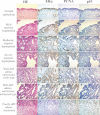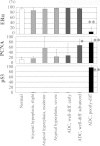Involvements of Estrogen Receptor, Proliferating Cell Nuclear Antigen and p53 in Endometrial Adenocarcinoma Development in Donryu Rats
- PMID: 23345926
- PMCID: PMC3517919
- DOI: 10.1293/tox.25.241
Involvements of Estrogen Receptor, Proliferating Cell Nuclear Antigen and p53 in Endometrial Adenocarcinoma Development in Donryu Rats
Abstract
Involvements of estrogen receptor (ER)α, proliferating cell nuclear antigen (PCNA) and p53 in the uterine carcinogenesis process in Donryu rats, a high yield strain of the uterine cancer were investigated immunohistochemically. ERα was expressed in atypical endometrial hyperplasia, accepted as a precancerous lesion of the uterine tumors, as well as well- and in moderately-differentiated endometrial adenocarcinomas, and the intensities of expression were similar to those in the luminal epithelial cells of the atrophic uterus at 15 months of age. The expression, however, was negative in the tumor cells of poorly differentiated type. Good growth of implanted grafts of the poorly-differentiated adenocarcinomas in both sexes with or without gonadectomy supported the estrogen independency of tumor progression to malignancy. PCNA labeling indices were increased with tumor development from atypical hyperplasia to adenocarcinoma. The tumor cells in poorly-differentiated adenocarcinomas were positive for p53 positive but negative for p21 expression, suggesting accumulation of mutated p53. These results indicate that the consistent ERα expression is involved in initiation and promotion steps of uterine carcinogenesis, but not progression. In addition, PCNA is related to tumor development and the expression of mutated p53 might be a late event during endometrial carcinogenesis.
Keywords: ERα; Endometrial adenocarcinoma Donryu; PCNA; p53; rat.
Figures



Similar articles
-
Neonatal exposure to p-tert-octylphenol causes abnormal expression of estrogen receptor alpha and subsequent alteration of cell proliferating activity in the developing Donryu rat uterus.Toxicol Pathol. 2002 May-Jun;30(3):357-64. doi: 10.1080/01926230252929936. Toxicol Pathol. 2002. PMID: 12051553
-
Hormonally active doses of isoflavone aglycones promote mammary and endometrial carcinogenesis and alter the molecular tumor environment in Donryu rats.Toxicol Sci. 2012 Mar;126(1):39-51. doi: 10.1093/toxsci/kfs016. Epub 2012 Jan 16. Toxicol Sci. 2012. PMID: 22248470
-
Modifying effects of ethinylestradiol but not methoxychlor on N-ethyl-N-nitrosourea-induced uterine carcinogenesis in heterozygous p53-deficient CBA mice.Toxicol Sci. 2000 Nov;58(1):43-9. doi: 10.1093/toxsci/58.1.43. Toxicol Sci. 2000. PMID: 11053539
-
Changes in biomarker expression in the development of prostatic adenocarcinoma.Biotech Histochem. 1997 Mar;72(2):86-95. doi: 10.3109/10520299709082217. Biotech Histochem. 1997. PMID: 9152521 Review.
-
Endometrial adenocarcinoma: beliefs and scepticism.Int J Surg Pathol. 2004 Apr;12(2):99-105. doi: 10.1177/106689690401200202. Int J Surg Pathol. 2004. PMID: 15173914 Review.
Cited by
-
Preclinical research models for endometrial cancer: development and selection of animal models.Front Oncol. 2025 Feb 5;15:1512616. doi: 10.3389/fonc.2025.1512616. eCollection 2025. Front Oncol. 2025. PMID: 39975595 Free PMC article. Review.
-
Predictive modes of action of pesticides in uterine adenocarcinoma development in rats.J Toxicol Pathol. 2015 Oct;28(4):207-16. doi: 10.1293/tox.2015-0026. Epub 2015 Aug 27. J Toxicol Pathol. 2015. PMID: 26538810 Free PMC article.
-
Enhancement of Uterine Cancer Development after Oocyte Depletion by Juvenile Exposure to Gamma Radiation in Rats: - A Comparative Study on Sensitivity of Damage to Female Reproductive Organs by Radiation between Juvenile and Adulthood Using a Rat Model.Food Saf (Tokyo). 2017 Dec 29;5(4):151-163. doi: 10.14252/foodsafetyfscj.2017017. eCollection 2017 Dec. Food Saf (Tokyo). 2017. PMID: 32231939 Free PMC article.
-
Increased susceptibility to mammary carcinogenesis and an opposite trend in endometrium in Trp53 heterozygous knockout female mice by backcrossing the BALB/c strain onto the background C3H strain.J Toxicol Pathol. 2019 Jul;32(3):197-203. doi: 10.1293/tox.2018-0057. Epub 2019 Apr 25. J Toxicol Pathol. 2019. PMID: 31404346 Free PMC article.
References
-
- Pintér A, Torok G, Borzsonyi M, Surjan A, Csik M, Kelecsenyi Z, Kocsis Z. Lon-term carcinogenicity bioassay of the herbicide atrazine in F344 rats. Neoplasma. 37: 533–544 1990. - PubMed
-
- Irwin RD, Haseman JK, Eutis SL. 1,2,3-Trichlopropane: a multiple carcinogen in rats and mice. Fundam Appl Toxicol. 25: 241–252 1995. - PubMed
-
- Picut CA, Aoyama H, Holder JW, Gold LS, Maronpot RR, Dixon D. Boromoethane, chloroethane and ethylene oxide induced uterine neoplasms in B6C3F1 mice from 2-year NTP inhalation bioassays: pathology and incidence data revised. Exp Toxicol Pathol. 55: 1–9 2003. - PubMed
-
- Nagaoka T, Takeuchi M, Onodera H, Matsushima Y, Ando-Lu J, Maekawa A. A sequential observation of spontaneous endometrial adenocarcinoma development in Donryu rats. Toxicol Pathol. 22: 261–269 1994. - PubMed
LinkOut - more resources
Full Text Sources
Research Materials
Miscellaneous
